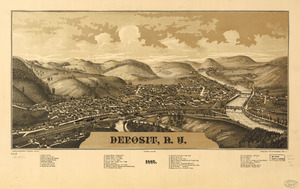Deposit, New York facts for kids
Quick facts for kids
Deposit, New York
|
|
|---|---|
| Country | United States |
| State | New York |
| County | Delaware |
| Government | |
| • Type | Town Council |
| Area | |
| • Total | 44.6 sq mi (115.5 km2) |
| • Land | 43.0 sq mi (111.4 km2) |
| • Water | 1.6 sq mi (4.1 km2) |
| Elevation | 990 ft (300 m) |
| Population
(2020)
|
|
| • Total | 1,427 |
| Time zone | UTC-5 (Eastern (EST)) |
| • Summer (DST) | UTC-4 (EDT) |
| ZIP code |
13754
|
| Area code(s) | 607 |
| FIPS code | 36-025-20357 |
| GNIS feature ID | 978899 |
Deposit is a small town in Delaware County, New York. In 2020, about 1,427 people lived there.
The town of Deposit is located on the western edge of Delaware County. It includes a village also called Deposit. Part of this village is actually in a different county, Broome County.
Contents
History of Deposit
The town's name, Deposit, comes from its early days. Lumberjacks would gather or "deposit" logs here. They would then tie the logs together to make rafts. These rafts would float down the Delaware River, often all the way to Philadelphia.
The Town of Deposit was officially formed in 1880. It was created from the western part of another town called Tompkins.
In the 1890s, Deposit became a place where many magazines were printed. A company called Outing Publishing moved there from New York City. They published several magazines, including The Bohemian. The company later closed down.
Geography of Deposit
The western edge of Deposit is the border with Broome County. The village of Deposit is where two waterways meet: Oquaga Creek and the West Branch of the Delaware River.
A major highway, the Southern Tier Expressway (NY 17), runs along the western border of the town. Another state route, New York State Route 8, starts near the village of Deposit.
The town covers about 115.5 square kilometers (about 44.6 square miles). Most of this area is land, with a small part being water.
Population Changes in Deposit
The population of Deposit has changed over the years. Here's how many people lived in the town during different census years:
| Historical population | |||
|---|---|---|---|
| Census | Pop. | %± | |
| 1880 | 1,714 | — | |
| 1890 | 1,664 | −2.9% | |
| 1900 | 1,747 | 5.0% | |
| 1910 | 1,641 | −6.1% | |
| 1920 | 1,415 | −13.8% | |
| 1930 | 1,469 | 3.8% | |
| 1940 | 1,443 | −1.8% | |
| 1950 | 1,570 | 8.8% | |
| 1960 | 1,560 | −0.6% | |
| 1970 | 1,656 | 6.2% | |
| 1980 | 1,810 | 9.3% | |
| 1990 | 1,824 | 0.8% | |
| 2000 | 1,687 | −7.5% | |
| 2010 | 1,712 | 1.5% | |
| 2020 | 1,427 | −16.6% | |
| U.S. Decennial Census | |||
In 2000, there were 1,687 people living in Deposit. About 31% of households had children under 18. The average household had about 2.4 people. The median age was 38 years old.
Cannonsville Reservoir
The Cannonsville Reservoir is a very important place near Deposit. It's about 3 miles (5 km) east of the village. This reservoir is a big source of drinking water for New York City.
Before the reservoir was built, some small communities, like Cannonsville, were covered by the water.
Communities and Locations in Deposit
The Town of Deposit includes several smaller communities and areas:
- Barbourville — A small community near the eastern town line, located on Route 8.
- China — A community in the northern part of the town, found on Route 20.
- Cannonsville Reservoir — The western part of this large reservoir and its dam are just east of the village of Deposit.
- Deposit — The main village, with its eastern part located north of the Southern Tier Expressway.
- Hale Eddy — A community in the southern part of the town.
- Hambletville — A community northeast of Deposit, also on Route 8.
- Stilesville — Another community northeast of Deposit, located on Route 8.
- Upper Barbourville — A community in the very northeastern corner of the town, on Route 8.
See also
 In Spanish: Deposit para niños
In Spanish: Deposit para niños



